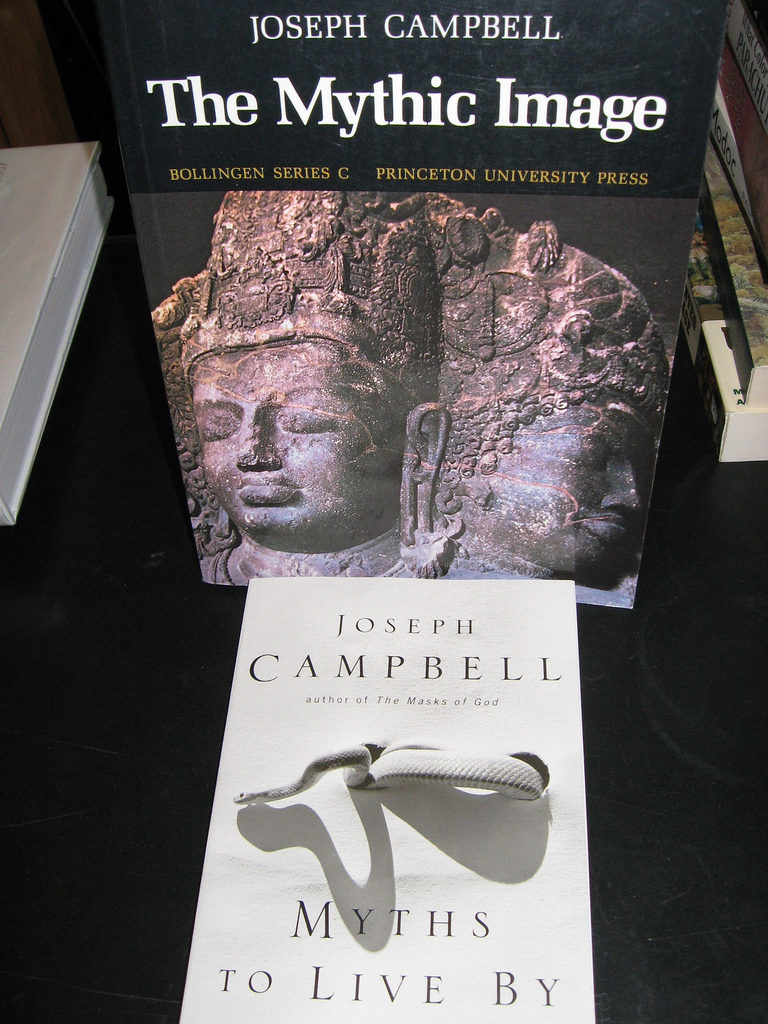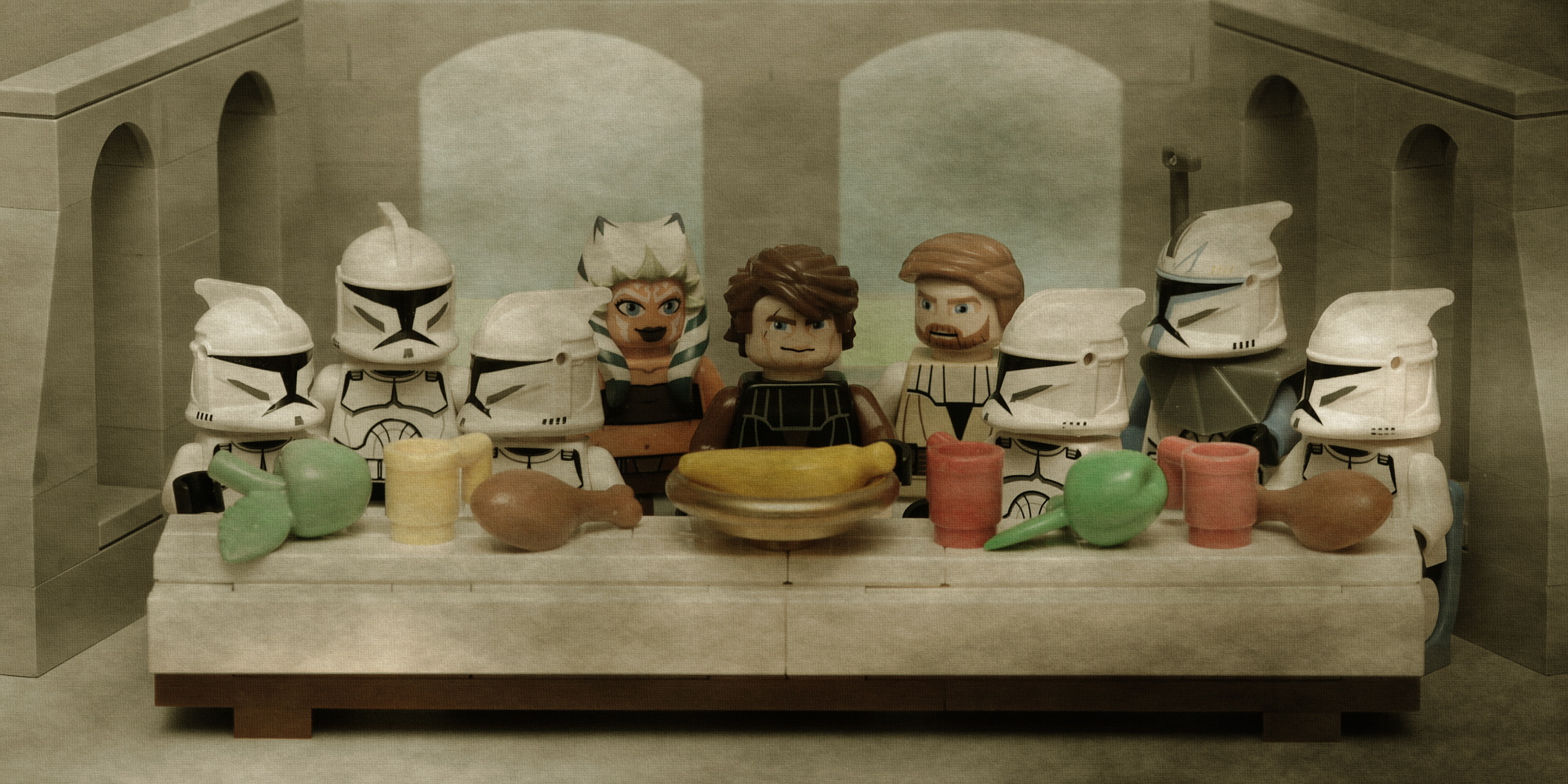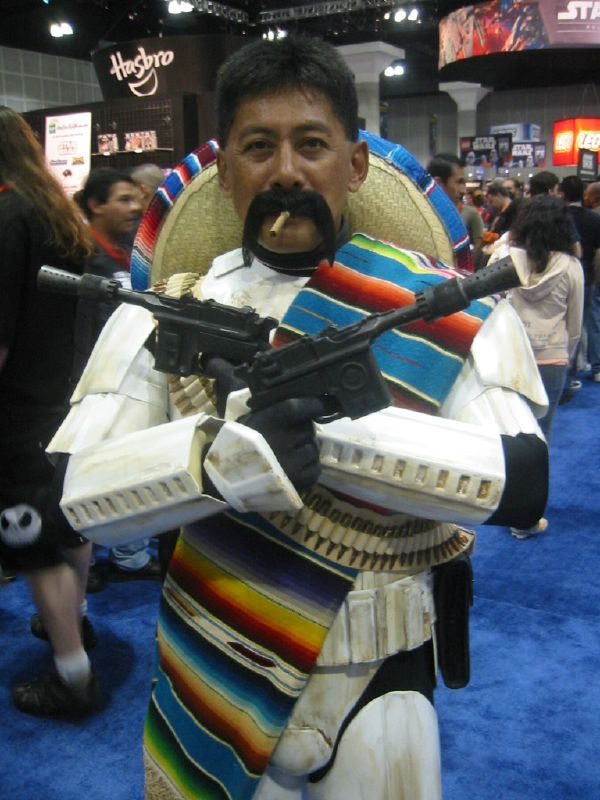
Ben Brazil
Even before the release of Star Wars: The Force Awakens, critics began zeroing in on a major complaint – that the film is a deeply unoriginal wallow in nostalgia. After it’s release, Salon quipped that readers need not worry about spoilers: they’d seen this movie before.
They’re not wrong. It did not take a superfan to notice the ways the movie’s plot both reincarnated the original – in 18 specific ways, according to Entertainment Weekly – and mixed it with plot elements from The Empire Strikes Back. Even favorable reviewers have declined to defend the final attack on Starkiller Base. As my six-year-old son sagely observed, “The Empire always builds its weapons with one big weakness.”
So it does. Yet after seeing the movie for the first time, I found myself, perversely, dealing with the opposite of the critical reaction. This cannot help but sound overwrought, but bear with me: I felt a sense of loss.
I was born the year Star Wars was released, and I saw Return of the Jedi in the theater between 15 and 20 times. I remember my mother asking me, perplexed, if I didn’t want to see something new. I said no.
To a significant extent, the conversation about Star Wars hinges on the same question: don’t we want something new? Put another way, differing opinions about The Force Awakens tend to hinge on how the reviewer judges the film’s balance of nostalgia and newness, of (cultural) history and change.
That tension is no accident. Instead, it sits at the heart of another term written into Star Wars’ DNA: myth. Famously, George Lucas modeled his narrative arc on the work of Joseph Campbell, whose The Hero With a Thousand Faces (1949) argued for the hero’s journey as “monomyth” – an archetypal story that undergirds sacred narratives in all cultures, in all times.

Contemporary religious studies scholars have largely rejected Campbell’s theory. Star Wars, however, continues to matter. Earning $1 billion at the box office in a record-breaking 12 days, The Force Awakens nearly ensures that Star Wars will remain part the warp and woof of American and global culture, a story that informs our banter, our holiday witticisms, our metaphors for politics, and our understanding of good and evil. Although loving Star Wars does not require any beliefs in the supernatural, it is a major piece of the shared, cultural fabric that we live in and through – what religion scholar Catherine Albanese called ordinary religion.
Nostalgic or not, Star Wars is also changing. When Disney bought Lucasfilm for $4.06 million in 2012, it acquired the entire Star Wars galaxy. In a revealing article at Wired, Adam Rogers reports that Disney understands its acquisition as a “paracosm,” an entire imaginary world with infinite space for characters and storylines, not unlike J.R.R. Tolkien’s Middle Earth or (more to the point) comic book movies. Disney now plans on releasing a new Star Wars movie every year.
Fueled by the Force of capitalism, this new galaxy has no space for endings, no interest in resolution. So what does it mean, this mix of newness, nostalgia, and capital? If Return of the Jedi froze the story’s happy ending in carbonite, what does it mean when it gets thawed out? When one of our great pop mythologies blinks at its surroundings and starts to move again?
***
Did you immediately answer that last question with a Jabba the Hut reference? If so, regardless of your wit, you are part of Disney’s target audience.
As am I. This September, I introduced my oldest boys, then 3 and 5, to the original trilogy. Since then, I have regularly served breakfast in the persona of Yoda (“Listening problem you have! Train you I cannot!) and discussed the pros and cons of using the hyperdrive on the way to school. I have put rocks in a backpack so my 5-year-old could train as a Jedi in our backyard Dagobah system. On Christmas Eve, my children went to mass. Over the following days, they received light sabers, Star Wars pajamas, an R2-D2 piggy bank, action figures, and items I am doubtlessly forgetting. Not all from me. But still.

Of course, the mix of commerce and religion is scarcely new in American culture. Disney, however, wagered not only on the traditional consumer orgy of Christmas, but on the specific likelihood that people like me would both invite our children into the fantasy world of our childhoods and purchase branded accessories for the excursion. It certainly didn’t hurt, nostalgia-wise, that stores brimmed with images of Luke, Han, and Leia, all looking exactly as they did more than three decades ago.
In the theater, however, life had moved on. Yes, everyone was grayer (even Chewie, I think). More importantly, the principals had suffered a rough, Baby Boomer middle age. Han and Leia had split up and watched their son make bad decisions, become someone they no longer recognized. Luke had isolated himself after failures at work.
If this was nostalgia – and it obviously was – it was the bittersweet nostalgia of visiting your childhood home after the new owners have remodeled it. It was the nostalgia of remembered daydreams, of horizons not-yet-narrowed by choices and time. It was, to be frank, a nostalgia for childhood fantasy and adolescent yearning, an emotion perfectly encapsulated by the scene of Luke Skywalker staring into the dual sunset of Tatooine, his theme music swelling behind him.
In other words, it was nostalgia for precisely the emotional world George Lucas intended to create.
***
When he was a young man, Lucas’s father pressured him to go into the family office supply business. Lucas balked. He refused the security his father had worked to provide and swore to “never work at a job where I have to do the same thing over and over again every day.” As Lucas told Charlie Rose in December 2015, it was among the biggest arguments he ever had with his father.
It was also a common script for middle-class white youth of the era. Underwritten by post-war America’s growing suspicion of institutions and widespread anxiety about conformity, the Romantic ideal of personal authenticity swelled in the 1960s and flowed into the 1970s. Among other things, it meant choosing your own way. Lucas also came to believe that, in the words of his mentor Joseph Campbell, it meant “following your bliss.”
Lucas also worried about his era (and ours). In 1970s America, he found “grayed” moralities, a lack of instruction on values like friendship, loyalty, and compassion. Young people setting out in the world, Lucas believed, needed more guidance. They needed stories to teach them and, as he told Bill Moyers in 1999, they needed “the same story over and over again every generation so that every generation gets it.” They needed the hero’s journey. As Lucas put it:
Myths help you to have your own hero’s journey, find your individuality, find your place in the world, but hopefully remind you that you’re part of a whole, and that you must also be part of the community, and — and think of the welfare of the community above the welfare of yourself.
Famously, then, Lucas modeled Star Wars on Campbell’s “monomyth,” understood as an essence that undergirds all religions. Its best best-known summary goes like this:
A hero ventures forth from the world of common day into a region of supernatural wonder: fabulous forces are there encountered and a decisive victory is won: the hero comes back from this mysterious adventure with the power to bestow boons on his fellow man.
Like Campbell, Lucas believed the story functioned mainly at the psychic level, via Jungian archetypes rooted in a shared unconscious. Luke Skywalker’s journey, it turns out, led to self-actualization. Jedis, as Lucas recently told Charlie Rose, were (among other things) “intergalactic therapists.” The hero’s journey, in short, provided the Romantic, coming-of-age blueprint that Lucas’s Sixties’ sensibility desired.

Star Wars’ debt to mythology also enmeshed it in nostalgia. In following Campbell’s blueprint, Lucas partook of a larger current of religion scholarship. Among its leaders was Mircea Eliade, a scholar now nearly as discarded as Campbell but far more erudite. In a once-revered book called The Myth of the Eternal Return, Eliade sought an antidote to what he called the “terror of history,” a purely secular vision of time in which change brought only loss and decay. For meaning, Eliade looked to myth and ritual. In them, he argued, societies found renewal by connecting to the founding of the world, to the “really real.”
Eliade and Campbell were certainly not identical thinkers. But given Star Wars’ explicit source in their intellectual universe, it should surprise no one that nostalgia lies at the root of both the rapture and criticism that has greeted The Force Awakens. The intellectual presuppositions of the originals militate against wholesale newness. Instead, it feels natural to identify with Han Solo when he re-enters the Millennium Falcon after a long absence. You’ve know the scene.
“Chewie,” he says, “we’re home.”
***
Of course, home has its problems.
For all Joseph Campbell’s lingering pop cultural cachet, there are few interpreters of religion more thoroughly rejected by contemporary scholars. Fueled by slipshod scholarship, the consensus goes, Campbell distorted genuine cultural differences into a one-size-fits-all mold –one whose glorification of the heroic individual fit both his own, conservative politics and the Reagan years.
Of course, Campbell did not distort Star Wars to fit his theory; Lucas explicitly modeled his story on the hero’s journey. Ironically, Star Wars may actually be Campbell’s most vital legacy. So surely it’s legitimate to view the films – even to experience them – via his lens?
Here is where I get conflicted. I love Star Wars. But nostalgia is sometimes less innocent than it seems; it can wrap the past in a golden haze, hiding its darkness and cruelty. Likewise, with their love of timeless essences, old-school myth theorists (and especially Eliade) have been associated with the fascism. Here, myth connotes (racial) purity, while the “terror of history” becomes contamination (attributed to Jews, or immigrants, or other outsiders).
Star Wars has itself been accused of many sins, including racism and sexism. In a 1999 Salon article, writer and astrophysicist David Brin also compares Star Wars unfavorably to Star Trek. Star Trek, he argues, celebrates the egalitarian force of science and the power of ordinary, engaged citizens to reform institutions. Star Wars, in turn, simply asks ordinary people to choose a side in a Manichean battle between Force-wielding elites.
Racist, sexist, anti-democratic: whether such critiques are convincing is a longer conversation. Lucas understood his original film as a dig at Vietnam; he has repeatedly stressed themes like interdependence. Doubtless, viewers and fans retain power to interpret the films as they see fit.
In fairness, Lucas also invited political analysis. In claiming to write a myth to point children to timeless truths, in offering his hero’s journey as a guide to coming of age, Lucas insisted that Star Wars was more than simple entertainment.
Of course – to return to the present – change has also come to the galaxy far, far away. As many (if not all) progressive commentators have happily noted, the updated Star Wars galaxy is less dominated by men, and especially by white men, the ever before. Its new heroes include a woman formidably strong in the Force and a black man dissenting from forced duty as a storm trooper. For good measure, the major new white male character is brutal, smug, and so insecure that he throws what my children have dubbed “light saber temper tantrums.”

And this is the truly interesting part of myth, according to a major branch of contemporary myth scholarship. As cultures undergo historical change, and as their own power dynamics shift, their myths shift with them. At least in this mythical world, we can see evidence that old racial and gender hierarchies are, at least, facing challenges. On the other hand, Star Wars remains an individualist galaxy; it’s just that the hero’s journey is now open to women and to non-whites.
But that’s something. It’s hard to write a story that is both utopian and compelling. And if you are attempting to locate a pop cultural space – or a culturally influential and pervasive story – entirely untouched by consumer capitalism, then I have Jedi Temple to sell you.
Ironically, Lucas told Charlie Rose that he would have engaged in less fan-pleasing nostalgia. The rise of a risk-averse, creativity-choking movie industry is, Lucas opined, one of the “abuses” of Star Wars’ legacy.
Nonetheless, The Force Awakens’ repetition of iconic moments (the father-son confrontation), its reshuffling of character roles (Rey as Luke, Han and Luke borrowing from Obi-Wan), and its re-use of plot structures (the whole thing) does not necessarily reveal an utter lack of creativity. It also reflects the balance of structure and change embedded in Star Wars’ intellectual DNA. To some extent, the nostalgia critique is the connoisseur’s lament: mass moviegoers’ bad, sentimentalist tastes simply will not support real, boundary-pushing art.
Whatever. I like unbridled creativity. I also like Star Wars. Reasonable people will disagree.
So, what now? Will Luke take the light saber proffered by Rey? Is there still good in Kylo Ren, as his mom thinks? What’s next for Finn? Will we learn what happened earlier on Jakku, or why C-3P0 has one red arm?
Who knows? But this much seems clear: even as parts of it stay the same, Star Wars will move. By marketing necessity if nothing else, its world will evolve in tandem with ours. It may take the easy road, as Abrams did by associating the First Order with Nazi Germany, the world’s safest evil empire. Or it may force us to think harder, just as the rebooted Battlestar Galactica series (which I loved) made viewers re-think torture and suicide bombing in the midst of the War on Terror.
Even if the series plays it safe, though, we will still learn something about what the movie-going public considers securely, profitably escapist. Which is to say that we will learn about what fantasies we desire and about what stories we want to believe.
After seeing The Force Awakens with my boys its first Friday, I returned with friends two days later. This time, freed from the baggage I took to the first showing, I watched the film for the wildly entertaining exercise in updated nostalgia that it is. And I experienced another feeling with religious significance: delight.
My children did not need a second showing to get there. They had known Luke, Leia, and Han for a mere four months. They were not surprised that their lives had gone on. They asked questions about Rey and observed that Kylo Ren’s mask was cool. Perhaps most telling, when my family prayed before dinner a few nights ago, both thanked God for the new Star Wars movie.
“Also for Jesus coming down as a little baby,” my wife reminded them.
“And for the new Star Wars movie,” my youngest said.
Amen.
Ben Brazil is assistant professor and director of the Ministry of Writing Program at the Earlham School of Religion (ESR), a Quaker seminary in Richmond, Indiana. With an academic background in American religious history and American religious cultures, Brazil has also freelanced for publications including The New York Times, The Washington Post, Killing the Buddha, and Religion Dispatches, among others. At ESR, he directs a writing program that seeks to work at the intersection of creativity, spirituality, service, and work for justice.
Cover photo by David Holt via Flickr CC BY-SA 2.0
